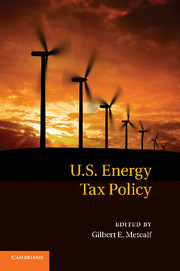Book contents
- Frontmatter
- Contents
- Conference Participants
- 1 Introduction
- 2 Distributional Impacts of Carbon Pricing Policies in the Electricity Sector
- 3 Distributional Impacts of a U.S. Greenhouse Gas Policy
- 4 Instrument Choice Is Instrument Design
- 5 Taxes, Permits, and Climate Change
- 6 Border Adjustments for Carbon Taxes and the Cost of Emissions Permits
- 7 Taxes and Caps as Climate Policy Instruments with Domestic and Imported Fuels
- 8 How Much Should Highway Fuels Be Taxed?
- 9 State Tax Policy and Oil Production
- 10 The Social Costs and Benefits of U.S. Biofuel Policies with Preexisting Distortions
- Comments
- Index
Comments
Published online by Cambridge University Press: 01 June 2011
- Frontmatter
- Contents
- Conference Participants
- 1 Introduction
- 2 Distributional Impacts of Carbon Pricing Policies in the Electricity Sector
- 3 Distributional Impacts of a U.S. Greenhouse Gas Policy
- 4 Instrument Choice Is Instrument Design
- 5 Taxes, Permits, and Climate Change
- 6 Border Adjustments for Carbon Taxes and the Cost of Emissions Permits
- 7 Taxes and Caps as Climate Policy Instruments with Domestic and Imported Fuels
- 8 How Much Should Highway Fuels Be Taxed?
- 9 State Tax Policy and Oil Production
- 10 The Social Costs and Benefits of U.S. Biofuel Policies with Preexisting Distortions
- Comments
- Index
Summary
I found the substance of the chapter by de Gorter and Just a useful addition to the policy discussion surrounding biofuels incentives. The potentially perverse effects of a double incentive of fuel mandates and tax incentives has not been as thoroughly treated as it perhaps should be. I doubt that most policy makers are aware of the idea that the authors demonstrate: that providing tax incentives for biofuels at the same time as the government requires the use of those fuels leads to greater overall fuel consumption than would otherwise occur in the absence of the tax incentive.
As the authors show, if a renewable fuel mandate – an ethanol mandate in gasoline in the simplified model of the chapter – is binding, then a lower ethanol tax rate does not further incentivize ethanol consumption. That level of consumption has been set by the mandate. Therefore, the lower ethanol tax rate – a result of the blender's tax credit in federal law – leads to a lower effective price for motor fuel in general, which promotes more motor fuel demand. As a result, demand for gasoline is higher, as the supply and demand of ethanol are pegged at the mandate. That is not to say that the mandate or the tax incentive alone will lead to higher gasoline consumption, but that in the presence of a mandate, gasoline consumption is expected to be higher if there is an ethanol tax credit than in the absence of such a credit.
- Type
- Chapter
- Information
- US Energy Tax Policy , pp. 380 - 386Publisher: Cambridge University PressPrint publication year: 2010

